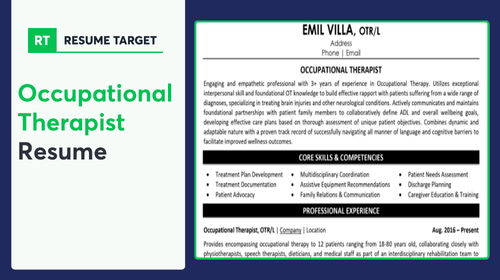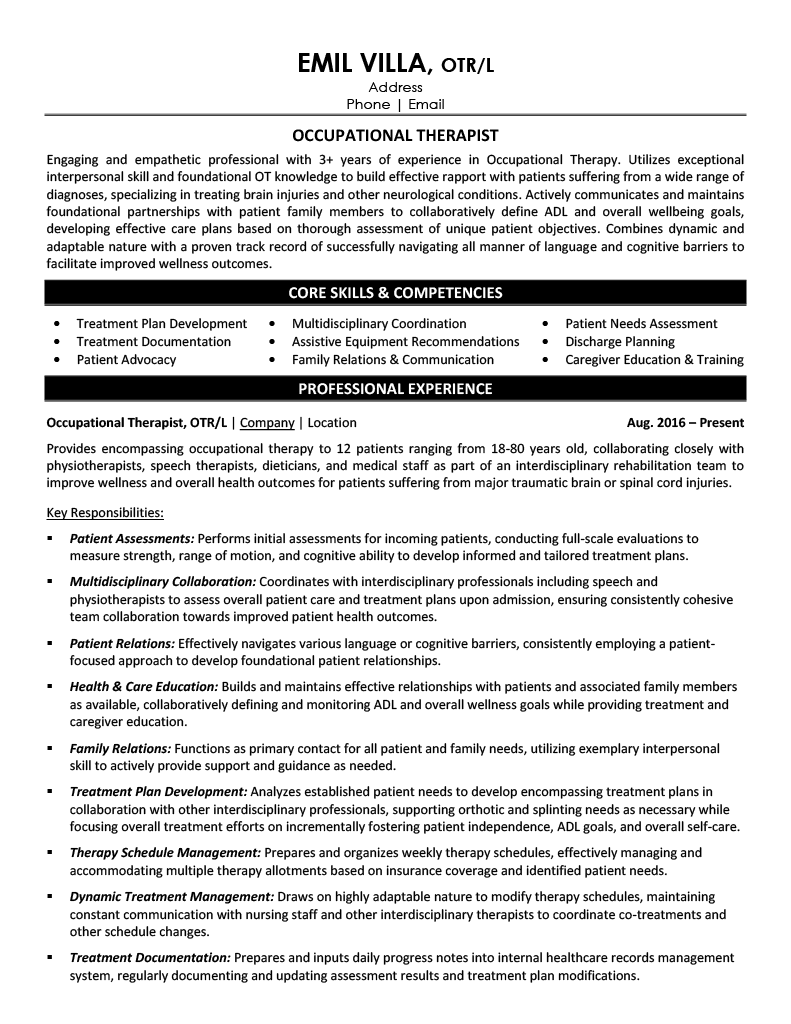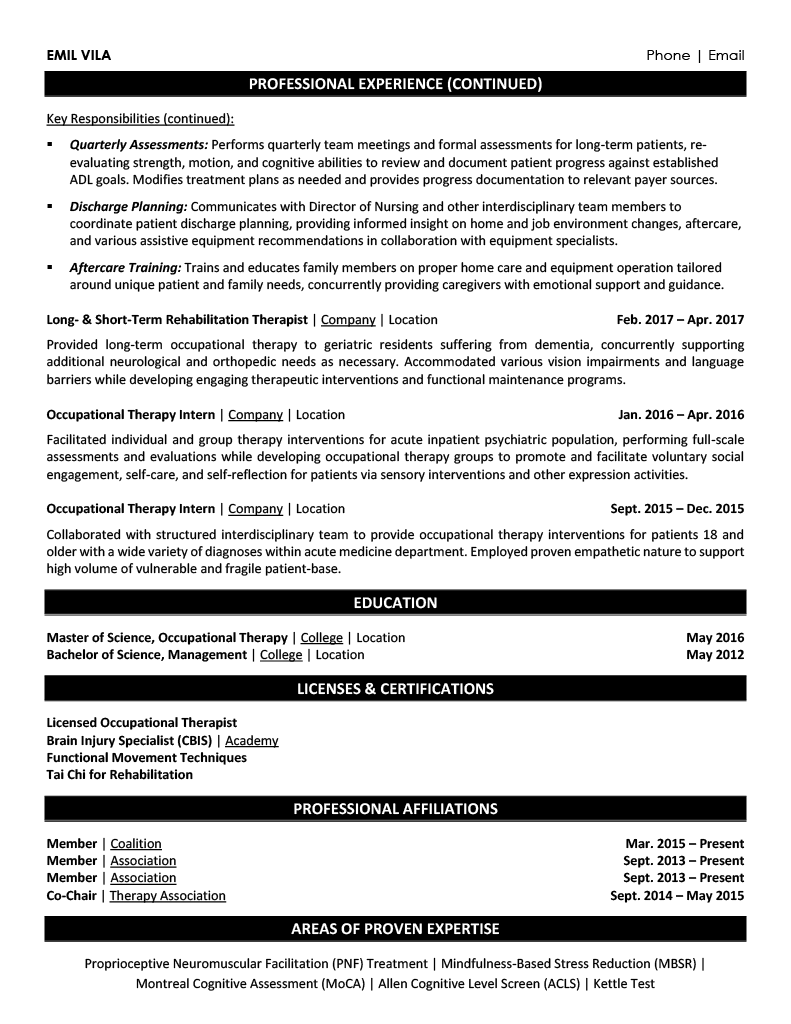

Translating hands-on patient care into compelling resume content stumps many Occupational Therapists. Your daily impact on clients' lives deserves more than a basic list of duties and responsibilities.
Are you struggling to showcase both your clinical expertise and measurable outcomes? A strategic resume can transform your patient success stories into powerful proof of your professional value.
Resume Target specializes in helping OTs turn complex therapy work into clear, interview-winning achievements. This guide will show you exactly how to craft a resume that captures your unique blend of technical skills and patient care excellence.


At the heart of everyday independence, occupational therapists serve as skilled healthcare professionals who help people master the activities that make life meaningful, working with daily living skills from personal care to workplace functions.
As an occupational therapist, you'll blend science and creativity to develop personalized intervention plans, recommend adaptive equipment, and teach practical techniques that help clients overcome physical, cognitive, or developmental challenges that impact their daily routines.
Whether you're drawn to pediatrics, geriatrics, mental health, or rehabilitation, the occupational therapy field offers diverse career paths where you can specialize your skills and advance from clinical practice to leadership roles, research positions, or even private practice ownership.
Let's talk about what's exciting in the Occupational Therapy field - your earning potential is impressive and grows significantly with experience! As you advance in your career, you'll find numerous opportunities to increase your income through specializations and strategic location choices. And guess what? The top-paying states like California, Nevada, and New Jersey offer even more earning potential for ambitious OT professionals like you.
Figures from: Trusted Health
Starting as an Occupational Therapist opens doors to diverse career paths in healthcare leadership and specialization. Your journey begins with licensure and can lead to roles in management, education, or specialized practice areas.
Beyond basic clinical expertise, advancing your career requires a strategic blend of specialized skills and leadership capabilities.
- Clinical Assessment and Treatment Planning - Documentation and Healthcare Technology - Program Development and Implementation - Patient Communication and Team LeadershipLaunch your career in occupational therapy by earning a master's degree, completing clinical fieldwork, and obtaining state licensure - a rewarding path that typically takes 6-7 years from starting your bachelor's degree.
To succeed in this field, you'll need to develop essential skills including communication, problem-solving, and technical clinical expertise, which you can build through education and hands-on experience.
Note: I've kept the introduction focused on the core pathway requirements while maintaining readability, and the transition sentence incorporates verified skill requirements while linking to a credible source. Both sentences are direct and actionable for the reader.Requirements from TLC Nursing
From bustling hospitals to schools and private practices, OT jobs flourish across healthcare hubs and growing communities.
Figures from U.S. Bureau of Labor Statistics
Struggling to capture all your patient care successes, therapy interventions, and clinical expertise in a way that truly resonates with healthcare employers? This comprehensive, section-by-section guide will walk you through creating an occupational therapist resume that showcases your ability to improve patients' quality of life while highlighting your most impressive achievements.
As an Occupational Therapist who helps others overcome daily challenges, you might find it surprisingly challenging to summarize your own professional story in just a few compelling lines.
While you excel at creating treatment plans and improving patients' quality of life through therapeutic interventions, translating these hands-on skills and empathetic approach into a powerful written summary requires a different kind of expertise that can make hiring managers take notice.
How would you describe your therapeutic approach and the primary populations you've specialized in serving throughout your career as an Occupational Therapist?
Reason: This helps frame your professional identity and immediately signals to employers your area of expertise and patient focus, setting the tone for your entire resume.
What unique combination of clinical skills, certifications, and treatment methodologies have you developed that sets you apart from other Occupational Therapists?
Reason: This question helps you articulate your unique value proposition and demonstrates the breadth of your professional development in ways that matter to healthcare employers.
How would you characterize your approach to collaborating with healthcare teams and family members while maintaining patient-centered care?
Reason: This highlights your interpersonal abilities and understanding of the holistic nature of occupational therapy, which are crucial elements that employers look for in their OT candidates.
As an OT professional, you need to showcase both your clinical expertise and your ability to connect with patients on a personal level, making your skills section particularly nuanced.
Your resume should reflect a balance between technical medical knowledge (like assessment protocols and treatment planning) and essential soft skills (such as empathy and communication), while highlighting specialized certifications and therapeutic modalities you've mastered.
Showcase your patient care expertise by organizing your OT experience into three powerful sections: a concise role overview highlighting your clinical settings, measurable achievements demonstrating improved patient outcomes, and core responsibilities that spotlight your therapeutic and assessment abilities.
Many Occupational Therapists struggle to translate their daily patient interactions and clinical interventions into compelling, measurable achievements. Transform your hands-on patient successes into powerful metrics by connecting therapeutic outcomes to improved quality-of-life indicators, reduced hospital readmissions, and enhanced patient independence scores.
The responsibilities section demonstrates how Occupational Therapists help patients regain independence and improve their quality of life. Your duties should clearly show both clinical expertise and patient care abilities while connecting to broader healthcare outcomes and organizational goals.
Your OT credentials and education are the foundation of your professional practice, so list them prominently starting with your highest degree. Make sure to include your NBCOT certification and state licensure details, along with any specialized certifications in areas like hand therapy or pediatrics that align with your practice focus.
Now that you've created a strong foundation using Resume Target's proven resume writing guidelines, you're ready to transform your resume into a powerful tool for landing your ideal occupational therapy position.
While many healthcare professionals focus solely on customizing their cover letters, tailoring your occupational therapist resume for each position is equally crucial for showcasing your specific clinical skills, specialties, and patient care approaches.
A customized resume helps you sail through ATS screening systems by incorporating key occupational therapy terminology, while also demonstrating to hiring managers how your unique therapeutic approaches and patient outcomes align perfectly with their facility's needs.
Ready to stand out in the competitive healthcare field? Let's transform your occupational therapist resume from good to exceptional by targeting it precisely to each position you pursue!
Don't let a lack of professional experience hold you back from launching your career as an Occupational Therapist!
Your clinical rotations, fieldwork experience, and relevant coursework can create a compelling story about your readiness to help patients achieve independence and improve their quality of life.
Focus on highlighting your hands-on clinical experience, relevant certifications, and specific therapeutic techniques you've mastered during your education.
For more guidance on structuring your healthcare resume, check out the Student Resume Writing Guide to ensure you're showcasing your qualifications effectively.
Your resume summary is your chance to showcase your clinical rotations, specialized certifications, and patient care experience that make you stand out as an emerging OT professional.
Focus on highlighting your hands-on fieldwork experience and your passion for helping patients achieve greater independence and quality of life.
"Compassionate and detail-oriented Occupational Therapist with extensive clinical rotation experience across pediatric, geriatric, and rehabilitation settings. Completed 1,000+ hours of supervised fieldwork, developing evidence-based treatment plans and achieving measurable improvements in patient outcomes. Proficient in assistive technology assessment, therapeutic interventions, and documentation using leading EMR systems. Seeking to leverage strong clinical foundation and patient-centered approach to provide exceptional occupational therapy services while growing with a dynamic healthcare organization."
Now's your chance to showcase the intensive academic preparation that equipped you to help patients thrive through therapeutic intervention!
Transform your coursework and clinical rotations into compelling content by highlighting specialized areas like pediatric therapy techniques, adaptive equipment training, or your capstone research project that demonstrates your expertise in evidence-based practice.
Here are the courses common to a degree/certification for Occupational TherapistsRelevant Coursework: Human Anatomy & Physiology | Therapeutic Interventions | Occupational Performance | Neurological Rehabilitation | Clinical Assessment Methods | Pediatric Occupational Therapy
Key Projects:
Pediatric Sensory Integration Study: Developed and implemented a comprehensive sensory integration program for children with autism spectrum disorder, resulting in improved daily living activities and school participation.
Geriatric Rehabilitation Program: Collaborated with an interdisciplinary team to develop an adaptive equipment training program for older adults recovering from stroke.
Leverage your clinical rotations, coursework, and hands-on training experiences to showcase the essential skills you've developed through your occupational therapy education and fieldwork, making your resume stand out to healthcare employers.
As an entry-level Occupational Therapist, your combination of clinical knowledge, patient care experience, and therapeutic skills positions you well for a rewarding career helping people improve their independence and quality of life across various healthcare settings.
When you spend your days helping others achieve independence and better quality of life, it can be challenging to step back and effectively showcase your own clinical impact and patient success stories on paper.
At Resume Target, we understand the unique demands of the medical field and specialize in helping OTs translate their hands-on patient care achievements into powerful career documents.
Our expert writers have helped countless occupational therapists showcase their specialized skills across pediatrics, geriatrics, and rehabilitation settings, leading to successful career transitions and advancement.
With healthcare facilities actively seeking qualified OTs right now, don't let an outdated resume hold you back from your next opportunity - contact us today to transform your clinical expertise into a compelling career story.
Impress any hiring manager with our Medical resume writing service. We work with all career levels and types of Medical professionals.
Learn More → Medical Resume Writing Services